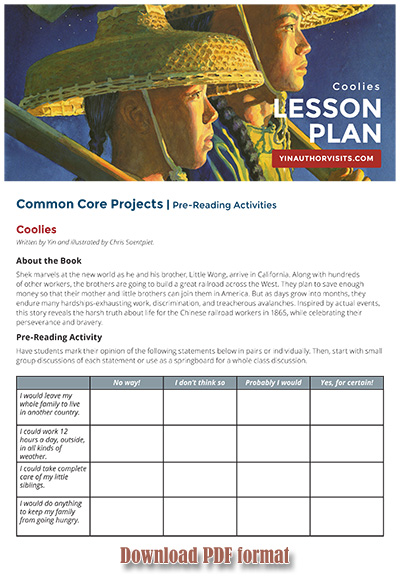|

ABOUT THIS BOOK:
When
Shek and Little Wong journey to America in 1865, they have work! Along
with hundreds of other Chinese, the brothers are going to help build a
great railroad across the West. But as days grow into months, Shek and
Wong endure more than they could have imagined-bleeding hands, blasting
dynamite, and treacherous avalanches. For very little pay. Are they being
treated this way because of their almond-shaped eyes-because they are
coolies? Inspired by actual events in the history of the American railroad,
COOLIES reveals the harsh truth about life for thousands of Chinese laborers,
while it celebrates the love and loyalty between two brothers who were
determined not only to survive, but to succeed.

MY
THOUGHTS ON ILLUSTRATING "COOLIES":
When I read the COOLIES manuscript,
I was immediately interested in the historical setting. I went to
the library to learn more about the Chinese railroad workers. This
will help me visualize how I want my paintings to look like. I needed
to know the type of ship to draw, how they bowed, how they wore
their hair, the style and color of the clothes they wore. I even
needed to know how the Chinese arranged the food on the table during
the 'Ching Ming' dinner celebration. For further research, I visited
the Golden Spike Museum in Utah. I even traveled to China for some
of the props. Each illustration would take me two weeks to paint
because of all the background details. The entire painting process
took me a year. -Chris Soentpiet
 WORDS FROM THE AUTHOR, YIN: WORDS FROM THE AUTHOR, YIN:
As a second generation Chinese-American, I grew up in Manhattan near Chinatown where I was exposed to my cultural heritage through Chinese and kung-fu school on Saturdays, and family gatherings over dim sum on Sundays. Because I did not learn about the Chinese contribution in American history in school, I felt the desire to research it later in life. My startling discoveries resulted in the story of COOLIES, which was my way of honoring the Chinese railroad workers' sacrifices and contribution.
Here I am standing at the meeting hall of the Consolidated Chinese Benevolent Association (aka: Chinese Six Companies) in San Francisco. In 1882, it was formed in response to racial attacks against the Chinese. It dealt with city, state, and national government regarding issues of immigration and persecution.
For the research of COOLIES, I interviewed my closest source, my grandmother. The Chinese railroad workers were mainly from my ancestral village in Toishan-Canton, China (the early Chinese-Americans speak Cantonese). Since this is a historical story, I had to compare my grandmother's memories to the information I collected at the library to make sure the events and dates are accurate. A trip to the Golden Spike Museum in Utah where they showed me some old original documents was an integral part of my research.
I hope you'll enjoy COOLIES as much as I've enjoyed writing it! -Yin
|

BOOK
REVIEWS:
As a boy and his grandmother celebrate the Ching
Ming Festival, a holiday honoring one's ancestors, the grandmother tells
the story of her great-grandfather, Shek, who came from China to California
in 1865 to work on the transcontinental railroad. Shek and his little
brother Wong endured the two-month trip to America and immediately signed
up with the Central Pacific Railroad Company to work as laborers. The
Chinese workers, known derogatorily as"coolies," from a Chinese word meaning"bitter
labor," were paid less than their European counterparts and were often
given the most dangerous jobs, those involving explosives, for example,
and were forced to work in terrible weather conditions. (The author's
note informs the reader that thousands of Chinese laborers died while
working on the railroad.) Shek and the other Chinese workers tried to
stand up for themselves by staging a strike, but were forced to back down
before any of their demands were met. Even when the railroad's completion
is celebrated, the importance of the Chinese laborers is ignored. After
four years on the railroad, Shek and Wong used their earnings to open
a store in San Francisco and eventually brought the rest of their family
over to the US. Soentpiet's signature glowing watercolors bathe the images
with light. The pictures of big scenes-the teeming shipyard, the crowded
living quarters on the ship, a campfire surrounded by snow-covered mountains,
a busy San Francisco street-are striking and grand. The design-each double-page
spread laid out with ¾ of the page as illustration while the ¼ on the
left holds the text in a box-allows for a fuller view of the sweeping
scenes. This is an important story,full of drama and emotion and it is
here given its proper recognition and tribute in both words and glorious
art. Perhaps it will encourage other grandparents to share their family
history as well. Masterful.
-KIRKUS REVIEWS
"Chris
Soentpiet's Coolies is illustrated with authenticity and drama, and gives
the Chinese people who participated in the building of the transcontinental
railroad dignity and respect - both for their hard work and their dedication
to family. The
word "coolies" reflects this. The character for "coo" stands for bitter,
but implies it is the taste of people who have experienced hardship and
survived. The character for "lies" means labor. Together
the characters mean more than bitter labor, however; they imply that it
is through laboring hard together that human beings become adults. It
is not surprising that the word "coolies" is regarded with respect by
the Chinese people--there would not be a Great Wall of China without their
bitter labor."
-ED YOUNG, Winner of the Caledcott Medal for "Lon Po Po"
"What
a beautiful book by Chris Soentpiet, revealing the important place of
the Chinese in our country's history: these humble laborers built a railroad
that united East and West. This title will be provocative for adults as
well as young people."
-JEAN FRITZ, Winner of the Newbery Honor Book, "Homesick"
PARENT'S CHOICE
(GOLD AWARD WINNER 2001): This grandly-conceived and beautifully-illustrated
oversize picture book merits praise and the widest possible readership.
It tells the epic tale of the role that unskilled Chinese laborers played
in the building of our transcontinental railroad. Through the story of
two young brothers, Shek and Wong, who leave Canton, China in the mid
1800s because of a famine and their family's desperate need for money,
we make the two-month crossing by ship to San Francisco, join them in
the grueling work of slamming sledgehammers into spikes to lay the rails,
and feel their loneliness and isolation as they are discriminated against
and paid lower wages than white workers. The text is simply and movingly
written; the pictures are little short of breathtaking. Oversized virtuoso
watercolors, they are teeming with people, with scenery, with the life
of the camps, with the dangers of the terrain. Considered "coolies," a
Chinese term for the lowest of unskilled laborers, they were not even
allowed to attend the celebration when Irish rail-layers from the East
met the mostly Chinese workers from the West at Promontory Summit, Utah.
It is a gripping story, magnificently illustrated--a book not to be missed.
- Selma
G. Lanes ©2001 Parents' Choice
Coolies depicts the story of two brothers, Shek and Wong from Canton China. They came to America in 1865, laboring to help build the transcontinental railroad from Sacramento to Omaha. The story also describes the hard life and dangers that Chinese workers faced during the construction of the railroad. The excellent use of color and true to life facial expression earns the book honors in illustration.
-Asian/Pacific American Librarians Association : Honorable Mention for Illustrations in Children Literature 2001

|
Theme: COOLIES can be used to introduce your students to
the history of the transcontinental railroad, immigration, foreign language, Chinese-Americans
and Chinese culture.
Pre-reading:
Show the students the cover of the book, read the title, author
and illustrator's name. Ask them what they think the book will be
about. Explain that the grandmother will tell a story that happened
many years ago. Have the students look at a globe or world map to
locate China and the United States.
Reading:
As you read and show the illustrations have the students look
closely at the drawings. What details can they find in the pictures?
Have them look closely at the expressions on the faces for the characters
-- how do they change during the story. Ask the students how they
think the characters are feeling. Can they tell by the illustrations?
The brothers are from Canton, China. Which body of ocean did they cross
to reach San Francisco by ship? Have a map nearby to measure the
distance. Which continent can China be found? How can we get to China today?
Interview:
Talk with a Chinese-American or someone who emigrated to
the United States -- then write their story.
Geography:
Before embarking on their long journey, Shek and Wong had to take
a few belongings. Have the students plan a trip to China and ask
them to estimate the miles, how long will it take, what will they
need to bring -- food, clothes, entertainment items, books etc.
What do the think they will see along the way -- will the see rivers,
mountains, lakes, deserts, plains, farms, factories, cities etc.
Science:
Using the food pyramid, plan meals for the proposed trip.
Are there snacks or any special foods your student's family members might require?
What is a rice
paddy? Try growing plants in a variety of ways -- soil, hydroponics
etc. Keep a journal of their growth. In COOLIES the brothers had
to cross a stormy ocean. Explore currents and how oceans flow. Do
lakes and rivers have currents, what other bodies of water have currents?
Social Studies:
Spend time studying Chinese history. What are the challenges
of the Chinese of today compared to the Chinese during the 1800s.
Ideally early February is the best time to study Chinese's history
as it coincides with Chinese New Year. Read the book, THE LAST
DRAGON written by Susan Miho Nunes.
Talk about immigration
-- are there any immigrants in the class -- list the countries of each
student's ancestry.
Make a guidebook
on China -- cover topics like cities, geographical features, customs,
traditions, folklore, early history, food, games, traditional dress.
Literature:
Read ORANGES
ON GOLDEN MOUNTAIN by Elizabeth Patridge, THE
LAST DRAGON by Susan Miho-Nunes, BROTHERS by Yin. Look for other books by Yin
or Chris Soentpiet. If you really enjoyed COOLIES
write a review and post it on-line at Amazon.com
or Barnesandnoble.com
so others can enjoy your reading experience.
Art:
Chris Soentpiet's art style is realistic. Have someone model and your students should
try to draw the model. Talk about different art techniques and the use of light
and shadow to make the drawings look real.
Bulletin
Board -Display a "sack" to have each student list what they
would pack if the had to leave home suddenly - remind them that
they will have to carry the "sack" for hours, so no televisions
please! |

|

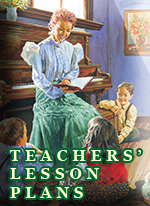
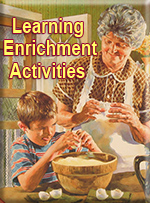
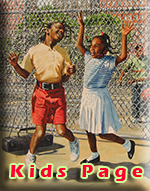

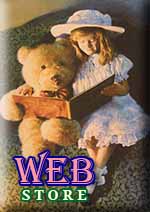
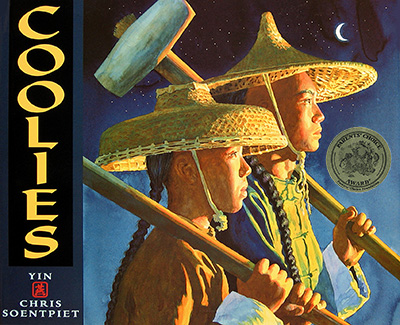

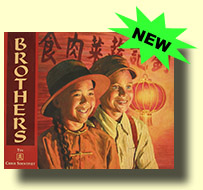
 WORDS FROM THE AUTHOR,
WORDS FROM THE AUTHOR, 